







Back to Observing Reports
Shakhbazian Compact Galaxy Groups Observing
Notes
In 1957, Romela Shakhbazian
examined a Palomar Sky Atlas plate and noticed a
tight group of red objects. She examined more plates
and found 16 more such groups and all were about 1
in diameter, so she wrote a journal article on it.
It was thought of at the time as a small tight
cluster of red stars. It wasnt until 15 years later
in 1972, when Robinson and Wampler took a closer
look and a spectrum of five objects in the first
listed group that Shakhbazian looked at and realized
that they were not red stars, but galaxies.
They named it Shakhbazian 1 to represent a new
system of galaxies called compact clusters of
compact galaxies.
In 1973, several others took a
new systematical search to look for more compact
clusters of compact galaxies on the Palomar Sky
Survey. The following criterion must be met to be
considered for the new system of galaxies:
1. Consists of 5 to 15 members.
2. Each galaxys apparent
magnitude is between 14th to 19th magnitude.
3. Compact group. Relative
distances of member galaxies should be 3/5 of the
diameter of a galaxy.
4. Almost all must be extremely
red. No more than two blue galaxies.
5. Galaxies must be compact. High
surface brightness, and not diffuse.
6. The group must be isolated.
It turned out that one of the richest groups was the first one, Shakhbazian 1. The spectra of the five objects in Shakhbazian 1 calculated the distance to be about 2 billion light years distant with a diameter of 620,000 light years across and the average diameter of individual galaxies was just 40,000 light years across. In comparison, the Milky Way and Andromeda Galaxy were about 100,000 and 130,000 light years across respectively, and 2.2 million light years from each other. It was also found that the absolute magnitude of the brightest member of Shakhbazian 1 is -23.0, which means that it is one of the brightest known galaxies. The velocity dispersion is very low, suggesting that they are together in one compact group. Imagine what that would look like for the deep sky observer from one of hte member galaxies! 5+ high luminosity galaxies crammed into a "small" 620,000 light year space.
Then in 1975 Mirzoyan, Miller, and Osterbeck
took a closer look at Shakhbazian 123 and determined that
it has similar characteristics to Shakhbazian 1. They
thought they were onto something. Further research on
other Shakhbazian groups showed that the pattern of small
velocity dispersion properties was indeterminate.
After research from 1972 to 1979, it
was demonstrated that most Shakhbazian groups are in one
of the following types of groups:
1. Spherical concentrated groups
2. Chains
3. Peripheric groups
Later observations of these groups with
high angular resolution revealed that member galaxies are
mostly of E and S0 types. This can be helpful for visual
observers as it was detectable even at 2 billion light
years distant. Also, it has now been shown that the group
members are not particularly compact, so the more recent
journal articles now call them Shakhbazian Compact Galaxy
Groups (Shk).
By 1979, the catalogue grew to 377 and was compiled by
Shakhbazian, Petrosian, Baier, and Tiersch. They produced
10 journal articles. The unfortunate thing was that the
coordinates of the groups in the original journal articles
given were relatively low accuracy, so more than a few of
the Shk groups were difficult to discern in galaxy-rich
fields. The good news, almost 20 years later, D. Stoll and
team put out ten papers on the photometry and the
identification of each member of the groups. I have used
his papers to center and mark the members in this
observing report. It also turned out that because of the
quality of the Palomar plates, some members were faint red
stars, not galaxies.
----
Since
this is a very challenging list, here are some
observing tips that will enhance your ability to see
them:
- A steady sky is key for resolving individual members.
- Take great care when looking. Stars appear brighter in
the eyepiece than the stars on the DSS and SDSS images
and gives false positives. Examine the provided
annotated images and note the locations of the
foreground stars.
- Keep your eyes dark adapted as fully as possible. Even the sky glow from the sky, especially if the Milky Way is above the horizon, can impact your night vision. When not looking at the eyepiece, waiting for your turn at the eyepiece, or just taking a break, look down at the dark ground, preferably with a hood over your head. I sometimes look down for a few minutes before looking in the eyepiece.
- To further darken the field around you, use a hooded vest. The hood should block all extraneous light, including the sky glow and even the Milky Way at very dark sites.
- Use your eyepiece guards. They offer an extra light blocking barrier between your eyepiece and your eye. If your eyepiece doesnt come with one, you can install one for some eyepiece. Click here for some ideas.
- If you think you saw the object(s), but are not sure, gently tap the telescope or wiggle it. The stars will wiggle in the eyepiece, and if you saw the object, it would wiggle as well along with the foreground stars.
- If you are tired, you won't see as much. Take a nap or rest. Try to observe in a comfortable position. It helps if you aren't straining your neck (or anything else) when you are trying to observe. Some fleeting objects would disappear when fatigued.
- Use high magnification, such as 300x or even higher. When I observe objects from this list, I generally use my 6mm ZAO-II, 5mm BGO, and/or 4mm ZAO-II orthoscopic eyepieces in my 22. I employ the TMB 1.8x ED Barlow if I need even more magnification.
- Use low-glass count and high transmission eyepieces. Even with modern glass polish and coating technology, there is still a very small, but noticeable difference between high glass count eyepieces, such as the common wide-field eyepiece versus a simple Orthoscopic or Plφssl. Over the years, Ive done many comparisons between various eyepieces, such as the Naglers, Ethos, Naglers, Pentax XWs, Orthoscopics (Zeiss, Baader, University Optics, etc.), and Plφssl (some makes) and found that low glass count eyepieces consistently outperform high glass count eyepieces. See Observing Tips, titled Going DEEP with simple eyepieces, for more information.
----
This
page contains my personal observations of the
Shakhbazian Compact Galaxy Groups.
Only galaxies seen are marked. The
numbering scheme used in the images are
consistent with D. Stoll's papers.
The idea
of this page is to encourage those with large
reflectors to give this catalogue a shot. This group
is considered the "next" Hickson Groups. All require
a large telescope to see the groups. An experienced
observer should be able to see what I saw.
Telescopes used:
- 22" f/4 reflector
- 30"
f/4.3 reflector
- 48" f/4 reflector
When you look through the eyepiece, just imagine
what you are really looking at...an isolated distant
compact group of galaxies that is not close to any
other galaxies. Not only that, these compact
groups contain mostly very luminous galaxies packed
in a small space, averaging less than a third the
distance between the Milky Way and the Andromeda
Galaxy. Each galaxy is even more luminous than
the Andromeda Galaxy. Just think about it, if
we lived in one of the stars in one of those
galaxies, there would be several to over 20 very
bright naked eye galaxies scattered throughout the
sky.
As I observe more Shakhbazian Compact Galaxy Groups,
I'll add them here.
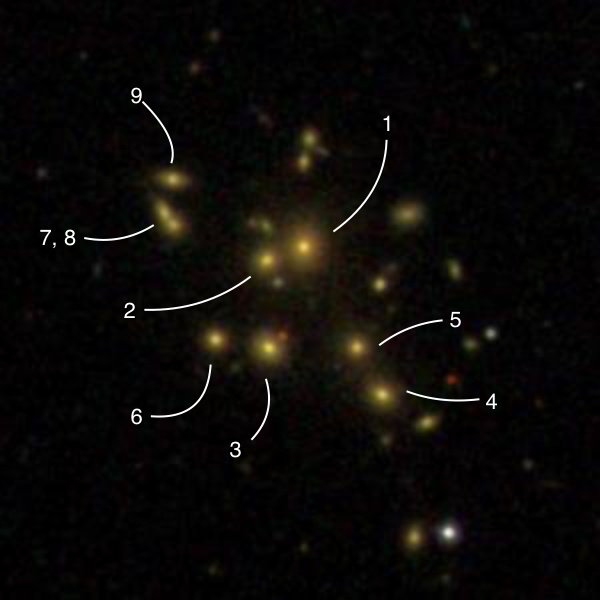
Shakhbazian 1
48 @ 488x 8 galaxies detected. The group is 1.1 in diameter.
1 and 2 were immediately picked up as a bright close double galaxy. 1 is slightly larger round glow than 2 with a brighter center and diffuse edges. 2 is round with a much brighter center with more defined edges than 1.
3 and 6 are considerably faint round glows with somewhat brighter centers. Both are about the same size.
4 and 5 are faint, very small and round.
9 is very faint, very small round glow. 7 and 8 are not resolved and appears as a very faint small round glow.

Shakhbazian 3
48 @ 488x Very faint unresolved diffuse glow. Could not pick out individual members.
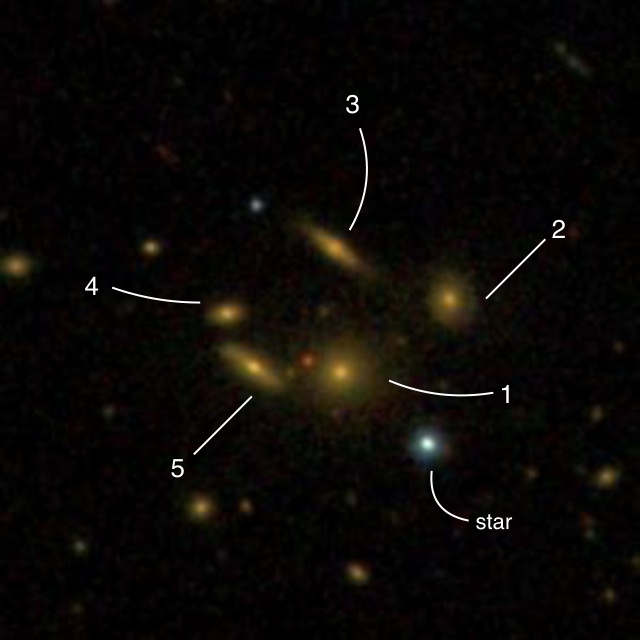
Shakhbazian 5
30 @ 538, 754 and 1256x
Component 1 (PGC 34447) and Component 5 (PGC 34452) were seen as a bipolar elongated patch. Not quite resolved.
Component 4 (PGC 34453) was suspected as an extremely faint patch attached to PGC 34452. The position angle of 1 (PGC 34447) and 5 (PGC 34452) is directly E/W. 1 (PGC 34447) was about 10 from a magnitude 16 star.
48 @ 488 and 610x The seeing wasnt that steady while I was at the eyepiece. Ive seen all five components at an earlier time with this scope, but unfortunately could not locate my notes. Detected only components 1, 3 and 5 as very to extremely faint very small round glows. A mag 16.7 star lies just 20 SW from component 1.

Shakhbazian 6
48 @ 488 and 813x - Nice group of five very faint very small round glows forming a backward L. The long end is 0.9 long and the short is 0.2 long. Component 2, MAC 1118+5144A, is a fairly faint small amorphous even surface brightness glow. 1 was not seen.
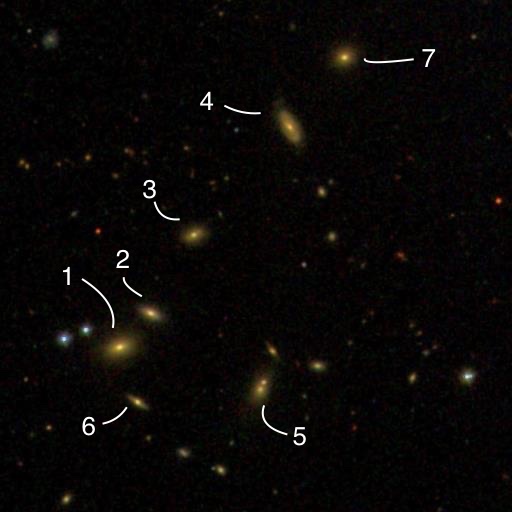
Shakhbazian 9
48 @ 488x A total of 7 galaxies seen in a chain with one off the west side. A faint double star lies just 9 west of the brightest galaxy, component 1. All are faint to very faint small round glows. A blazing mag 8.1 star lies 4.5 SW from component 7.
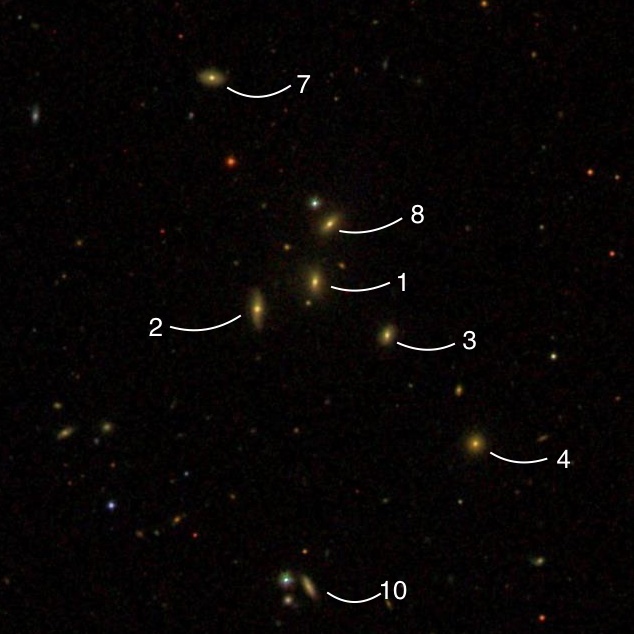
Shakhbazian 11
48 @ 488 and 610x Seven galaxies detected as faint to very faint small round glows. A faint star is just 10 east of component 2. A very faint star is just 10 NE of component 8.

Shakhbazian 13
22 @ 328, 383, and 460x The
west member 1 is a faint 2:1 elongated glow with diffuse
edges.
A very faint trio of stars, roughly a
45-degree right triangle, are north and to the east. An
extremely faint galaxy 9 seen to the east.
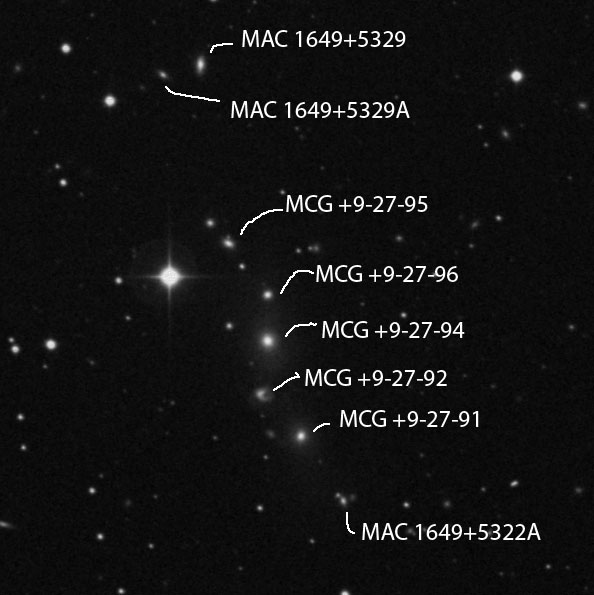
Shakhbazian 16
22 @ 203, 293, 377 and 528x
Five galaxies are chained in a rough N-S line and almost equally spaced. From top to bottom are MCG+9-27-95, -96, -94, -92 and -91. They are roughly 45 to 60 apart. A 8.7 magnitude star lies just 1.2 ESE of the top member.
MCG+9-27-95 Very faint, extremely small round patch. About 10 across and even surface brightness. A 16th magnitude star lies about 20 NE
MCG+9-27-96 Very faint, extremely small round patch. About 10 across and even surface brightness.
MCG+9-27-94 Considerably faint, very small round patch of about 20 diameter. It has a gradually brightening center.
MCG+9-27-92 Considerably faint, very small round patch. About 15 diameter
and even surface brightness throughout.
MCG+9-27-91 Considerably faint, very small round patch, with a very slightly
brighter center. About 20 across.
MAC 1649+5322A not seen

Shakhbazian 19
22 @ 306 and 460x - This was observed at the Texas Star Party under NELM 7.2 skies. The unresolved group appeared as an extremely faint slightly elongated glow.
PA = 90° and less than 10 across. The star to the north was not detected.
30 @ 542x The glow is a 2:1 elongated unresolved glow. PA = 90. The star was detected and brighter than the unresolved glow.
48 @ 813x Galaxies 1, 4 and 5 - Appeared as three distinct nuclei immediately detected. Galaxy 2 a thin glow with a nearly stellar core with PA = 150.
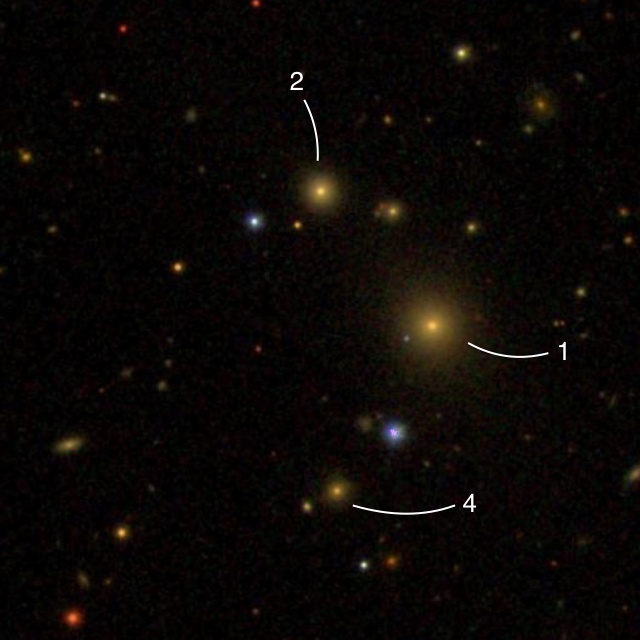
Shakhbazian 21
22 @ 383, 460 and 591x Three galaxies detected.
1 very faint, very small round even surface brightness glow.
2 very faint small round glow with a stellar core.
4 extremely faint very small round glow.
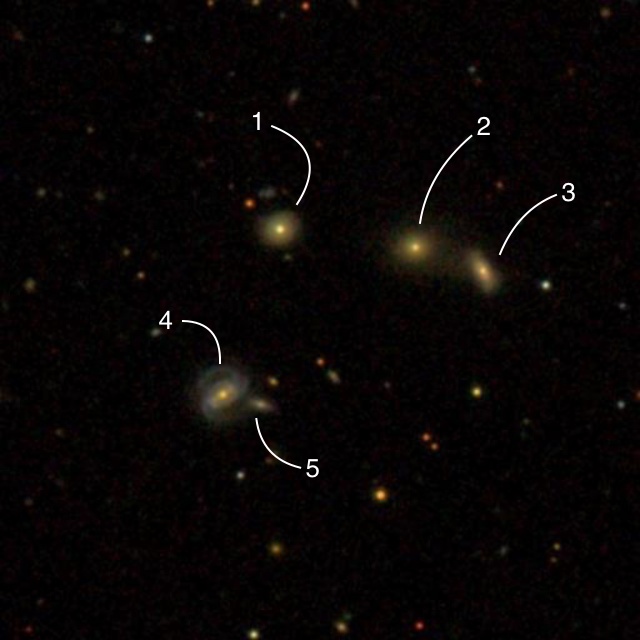
Shakhbazian 22
48 @ 488x and 610x Total of five galaxies seen.
Component 4 is a fairly faint small round glow with component 5 just off the west edge.
The other three components; 1, 2 and 3, are faint small round glows.
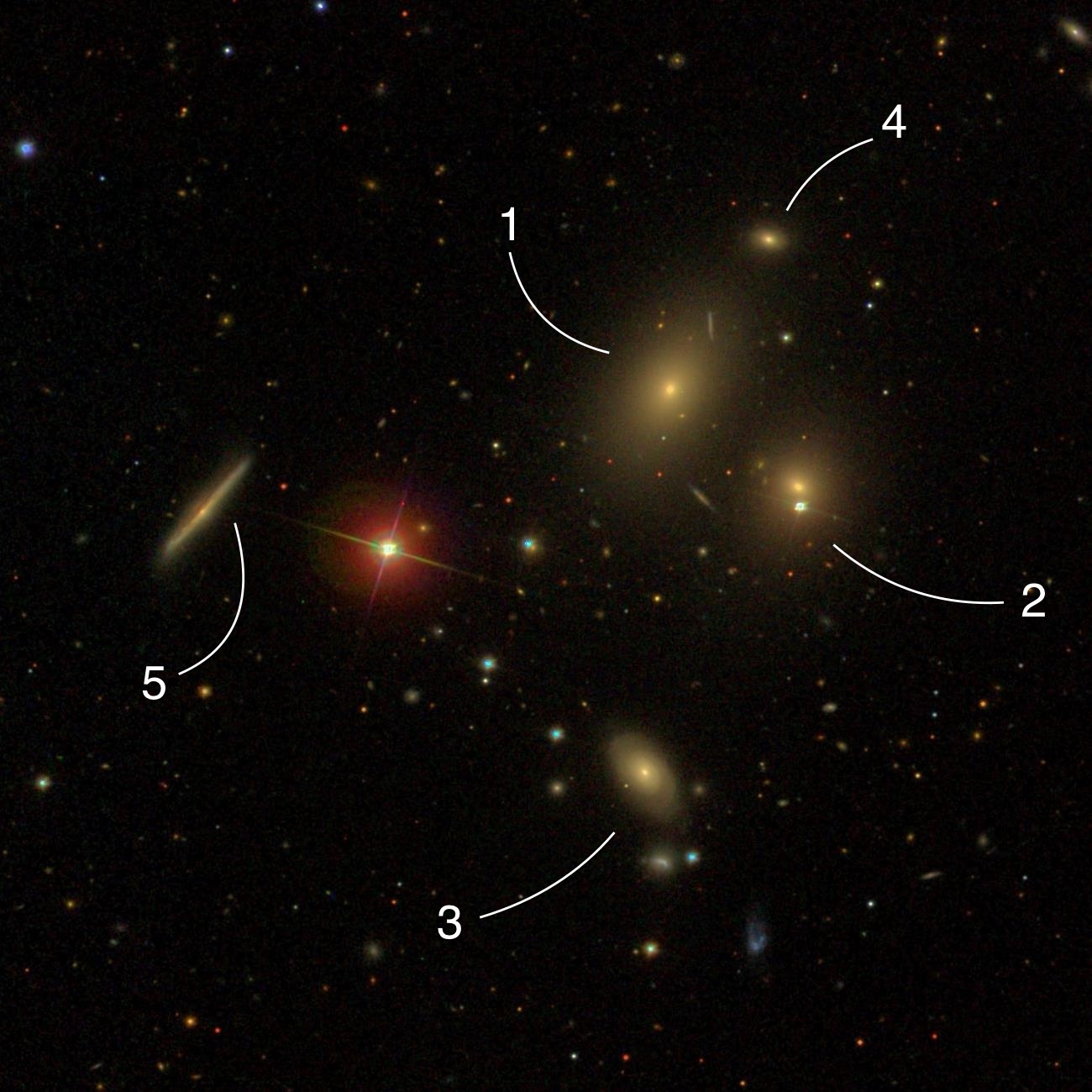 Shakhbazian
30
Shakhbazian
3022 @ 203, 377 and 528x
At 377x, this nice group shows four bright members and one small faint elliptical. A 11th magnitude star is in the mix of this group that fits in a circle about 5 arc-minutes in diameter.
Component 1 (IC 5357) This dominant elliptical is a very bright, 2:1 elongated oval with a brighter center with a position angle of 140˚. Averted vision shows a little more up to 90. An 11.2 magnitude star lies 2 SE.
Component 5 (IC 5359) Faint and very thin streak lying about 4 ESE of IC 5357. No sign of a nucleus was visible. The position angle is about 135˚ and 75 long and about 10 thick. More magnification did not improve the view of this edge-on spiral galaxy.
Component 3 (IC 5356) Bright and 2:1 elongated patch. Even surface brightness with a brighter core. PA = 45 and is 45 long. This member lies 3 due south of IC 5357. A pair of 15th magnitude stars lie 45 south.
Component 2 (IC 5351) This very small galaxy has a very dominant nucleus. Bumping it to 528x, the extension grew by about 20. This small elliptical lies 1 SW of IC 5357.
Component 4 (PGC 72405) Very small faint round smudge about 1 NW of IC 5357. Less than 10 in diameter.
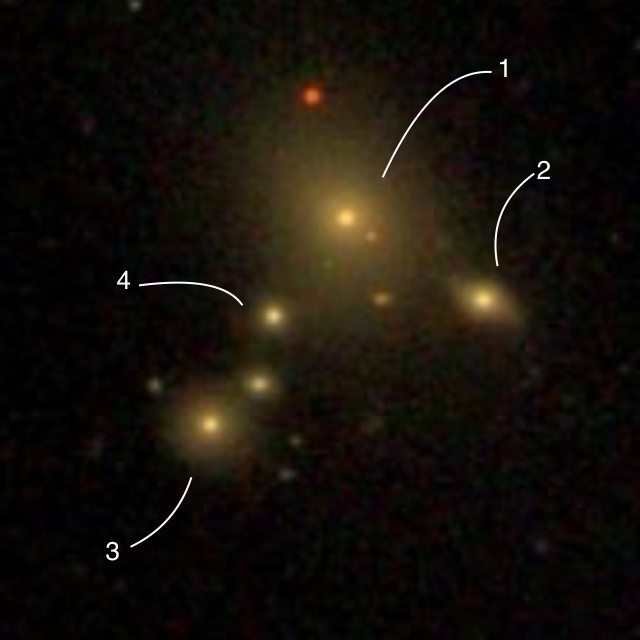 Shakhbazian
35
Shakhbazian
3522 @ 383, 460 and 591x total of four members seen.
The brightest one, 1, is the right angle of a 30-60-right triangle. Faint round even surface brightness glow.
Component 2 at the 60-degree angle and component 3 at the 30-degree angle appear as very faint round even surface brightness glows.
Component 4, is an extremely faint very small round glow is between 1 and 3.
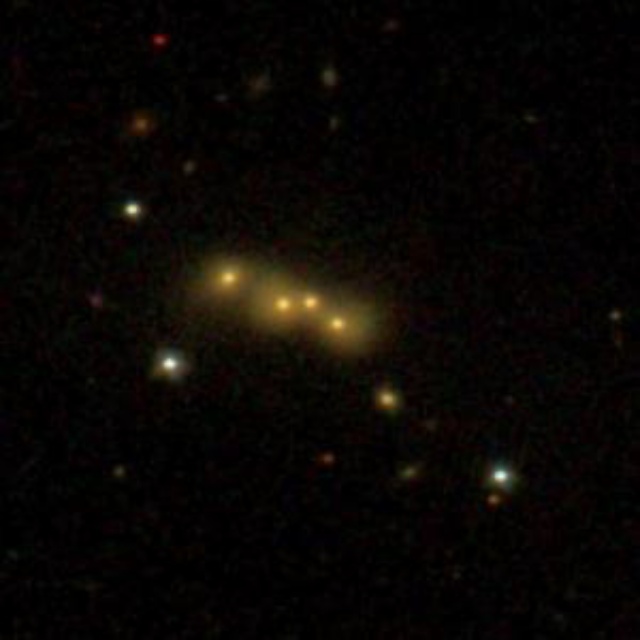
Shakhbazian 38
22 @ 383x Unresolved mass, even surface brightness thin glow. PA = 60° and 0.5 x 0.1 in size. A 15.8 mag star lies 0.4 SE from the center.
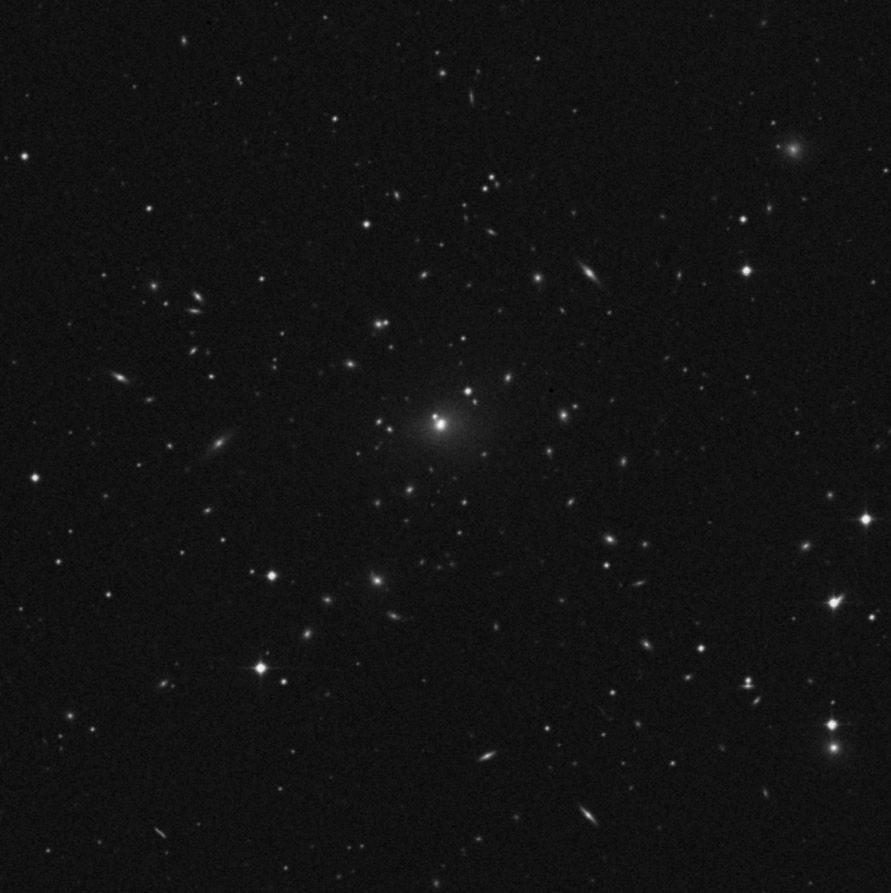
Shakhbazian 40
22 @ 383x One considerably bright round glow with defined edges in the middle with a bunch of faint to extremely faint galaxies surrounding it. I didnt mark each member, but there are at least 15 galaxies up to 5 from the center galaxy.
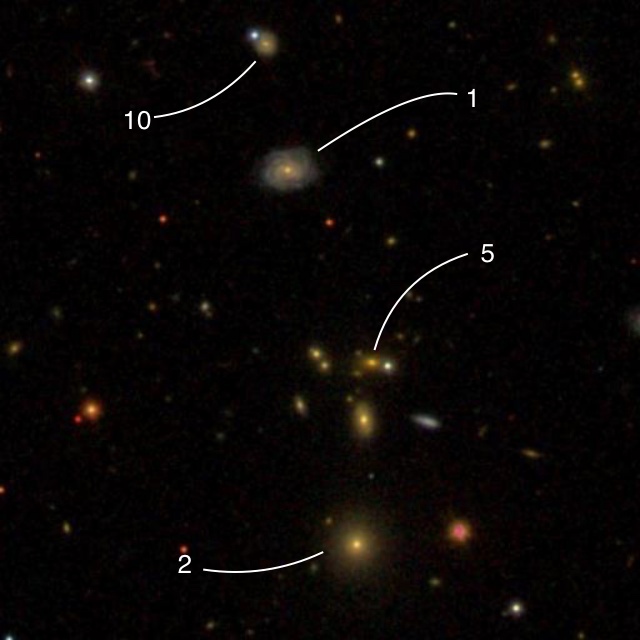
Shakhbazian 44
22 at 328, 383, 460 and 591x Four members detected. Starting from the south end.
2 very faint round small glow.
5 extremely faint, very small round glow with an extremely faint star just west.
1 extremely faint round glow with diffuse edges.
10 very faint very small round glow. (Now not sure if I saw the star or the galaxy.)
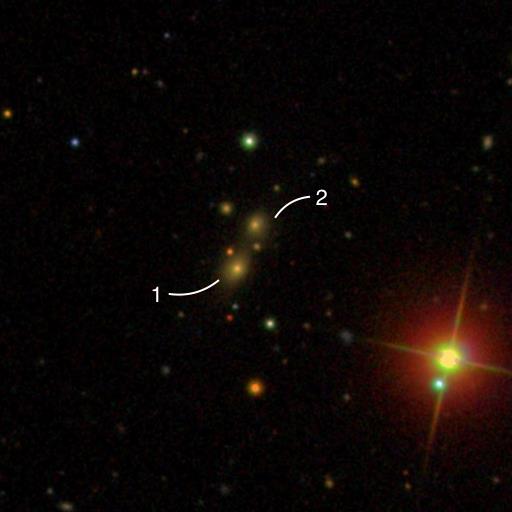
Shakhbazian 49
22 @ 383, 460 and 591x two extremely faint, very small round faint glows seen about 30 apart. PA = 20
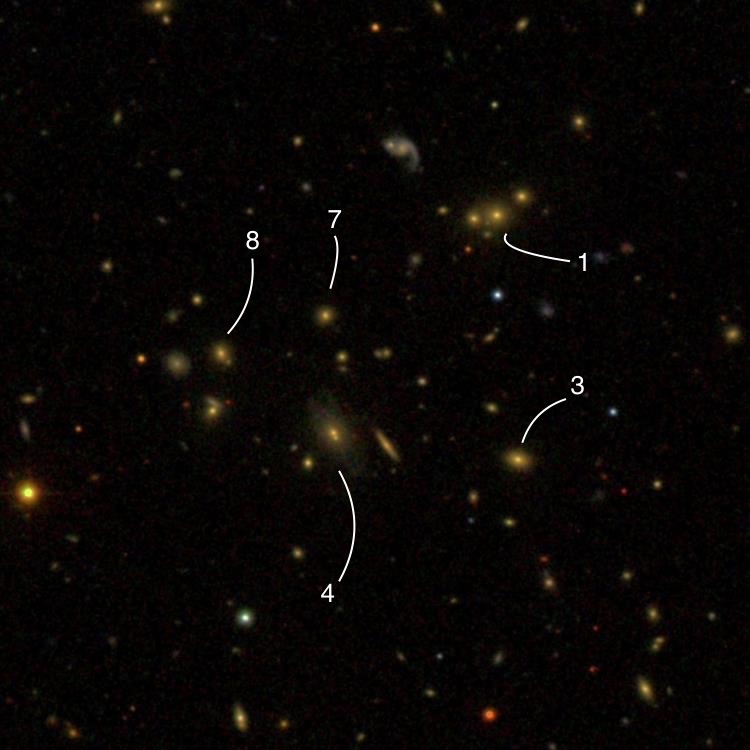
Shakhbazian 53
22 @ 383 and 460x Just 5 members seen. All are very faint to extremely faint. See photo. I should have increased the magnification higher.

Shakhbazian 54
22 @ 383 and 460x A bright foreground star interferes with the observation of this group. Need to use a narrow field eyepiece and keep it off the field. With it in the field, I could see only 1 or 2 galaxies. With it off the field, six galaxies are seen. All are very to extremely faint small glows.
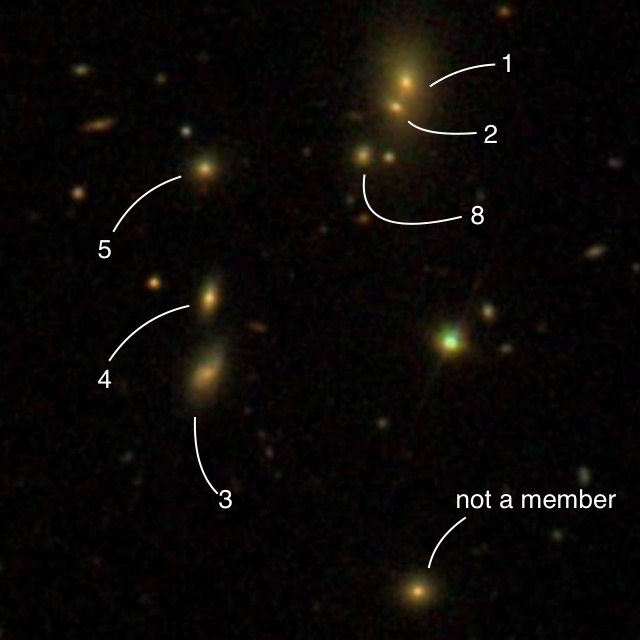
Shakhbazian 60
48 @ 488x - Seven galaxies seen in a rough crescent arrangement with the cusp pointed to the west. 2 long from N to S and 1.2 wide. Component 1 is the brightest of the bunch with a very faint nearly stellar companion that is barely resolved on the SSE edge. Component 4 was detected as a nearly stellar galaxy while component 3 is a 2:1 even surface brightness glow. PA = 135 and 0.1 long. The rest are very faint very small round glows and all are <0.1 across.

Shakhbazian 63
48 @ 375 and 488x 3 members seen forming an equilateral triangle with each side being 0.5 across. Actually, the two double galaxies were not resolved, the west pair is a very faint soft round glow, and the SW pair is an extremely faint round glow.
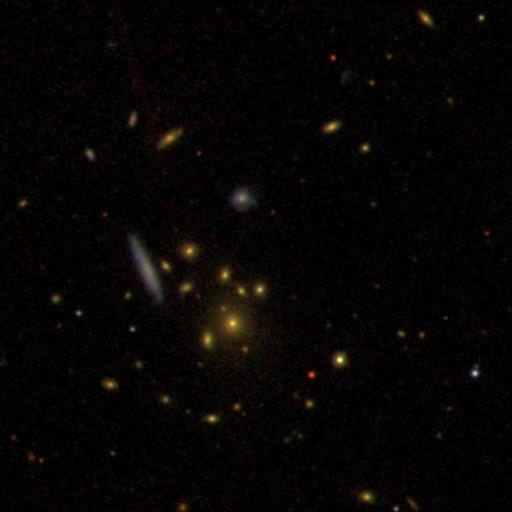
Shakhbazian 79
48 @ 488x Not much was seen but an unresolved glow.
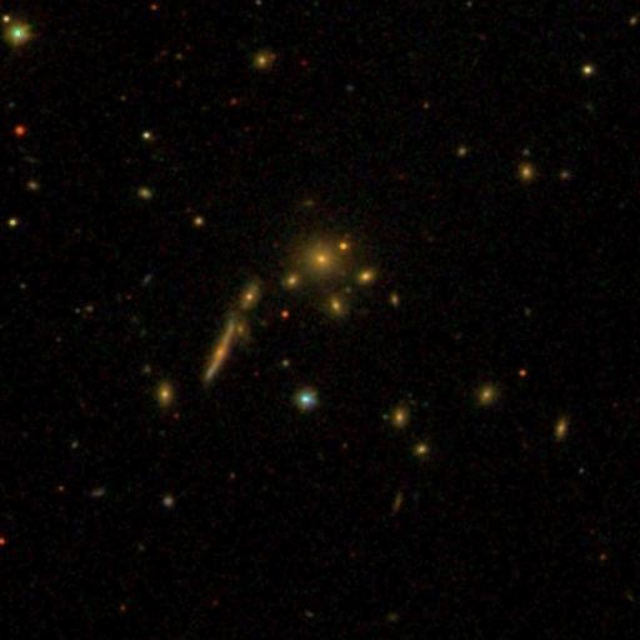
Shakhbazian 81
22 @ 306 and 460x Very faint unresolved clump. It sits closest to the SW star of the equilateral triangle.
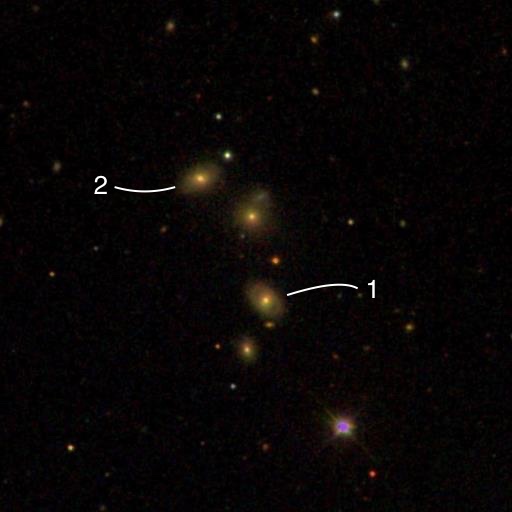
Shakhbazian 84
22 @ 306 and 460x 2 extremely faint glows detected with averted vision. Component 2 lies just 34 north of component 1. A 14.2 magnitude star lies 45 SSW from the southern galaxy.
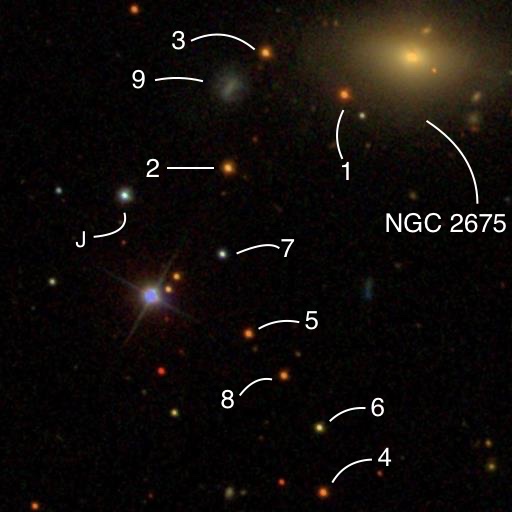
Shakhbazian 98
48 @ 488, 610 and 813x A curved chain of seven faint galaxies (marked as 2 to 9), which seven are nearly stellar. I didnt detect the galaxy labeled as 9. 1 is just off the SE edge of NGC 2675. J, a non-member, is the brightest of the very small stellar galaxies and lies about 45 east of the upper middle part of the chain. A 13.0 mag star lies 30 east from the center of the chain. Nearby galaxy, NGC 2675 is a very bright slightly elongated glow with diffuse edges and a much brighter small core.
Note: Most of the objects are faint stars, but the chain is still cool to observe.

Shakhbazian 154
48 @ 488x 9 members detected. Ranging from considerably bright to extremely faint.
9 is considerably 2:1 elongated glow with a stellar core and defined edges.
1, 2, 3 and 4 are equal in brightness while 1 is a little larger than the other three. They are a little fainter than 9, round with brighter center and somewhat diffuse edges.
Galaxies 7 and 8 are slightly fainter than 1 to 4. All are round and have even surface brightness.
10 is very faint, very small round glow.
5 is extremely faint very small round glow.
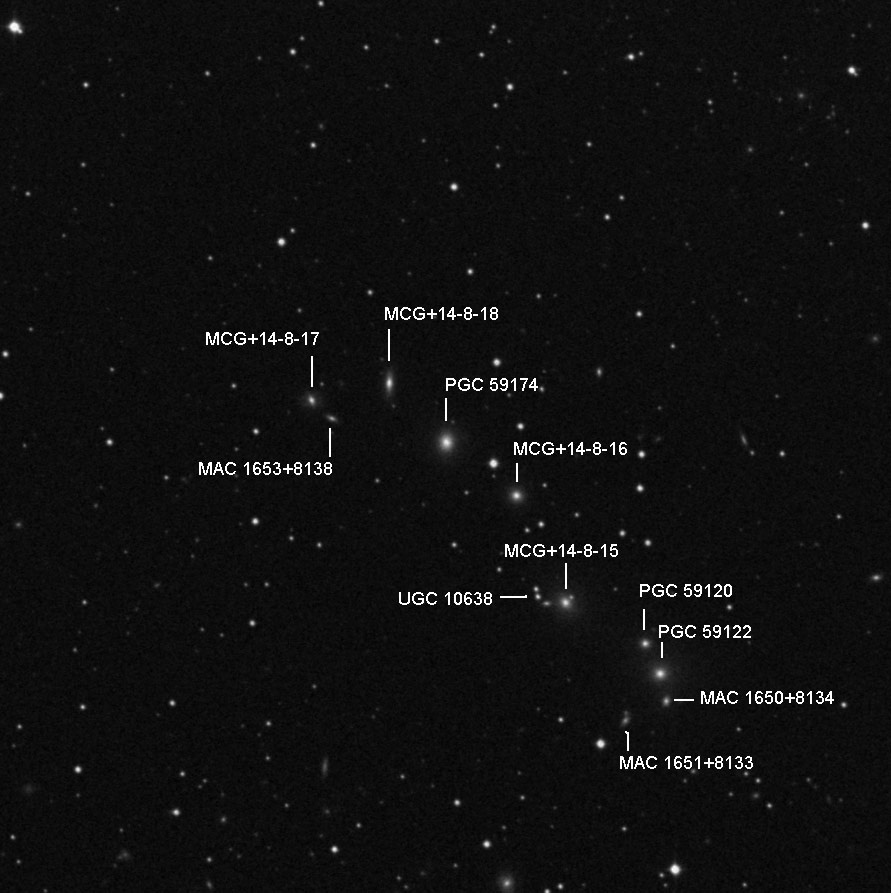
Shakhbazian 166
22 @ 308x
Shakhbazian 166 is one of the brightest examples of this catalogue. It consists of 10 galaxies which most of them are in a nice chain of about 8 long ranging from mag 14.9 to 16.5.
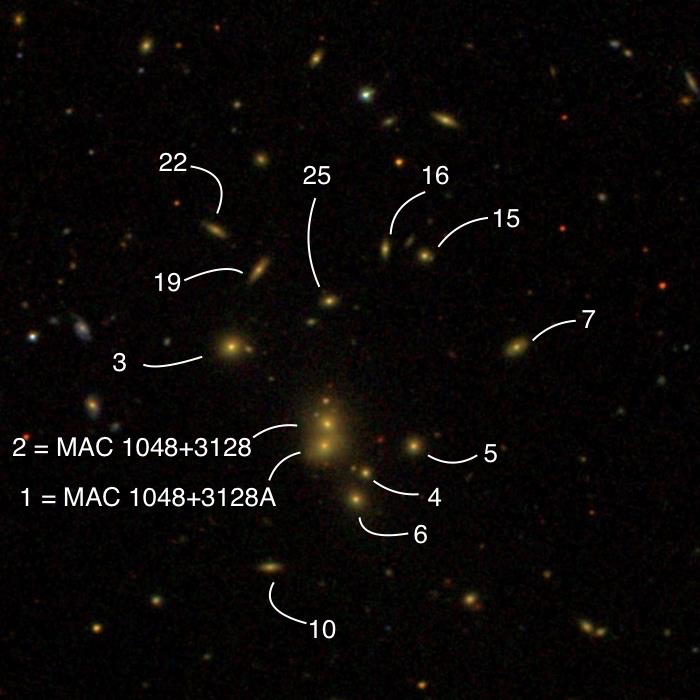
Shakhbazian 191
48 @ 488 and 610x A total of 13 galaxies seen and all are labeled. The brightest galaxies are the two MAC galaxies labeled on the chart and both are fairly bright round glows that are almost merging. About 0.1 apart. 3 is the third brightest and detected as a small round glow with defined edges. 0.1 across. 5 is extremely faint nearly stellar glow. The rest are faint to extremely faint very small round glows.
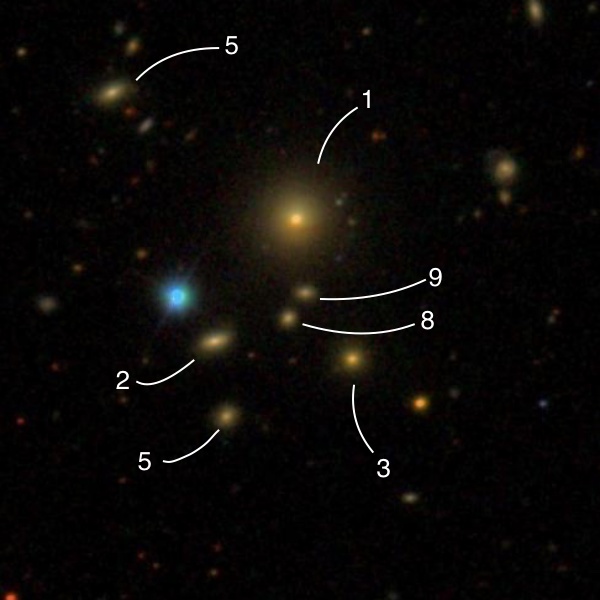
Shakhbazian 199
48 @ 488x Only 7 galaxies seen in the field. Component 1 is a considerably bright round glow with a brighter center and diffuse edges. 0.2 across. Component 8 is a nearly stellar fuzzy star. The rest are faint to very faint round glows.
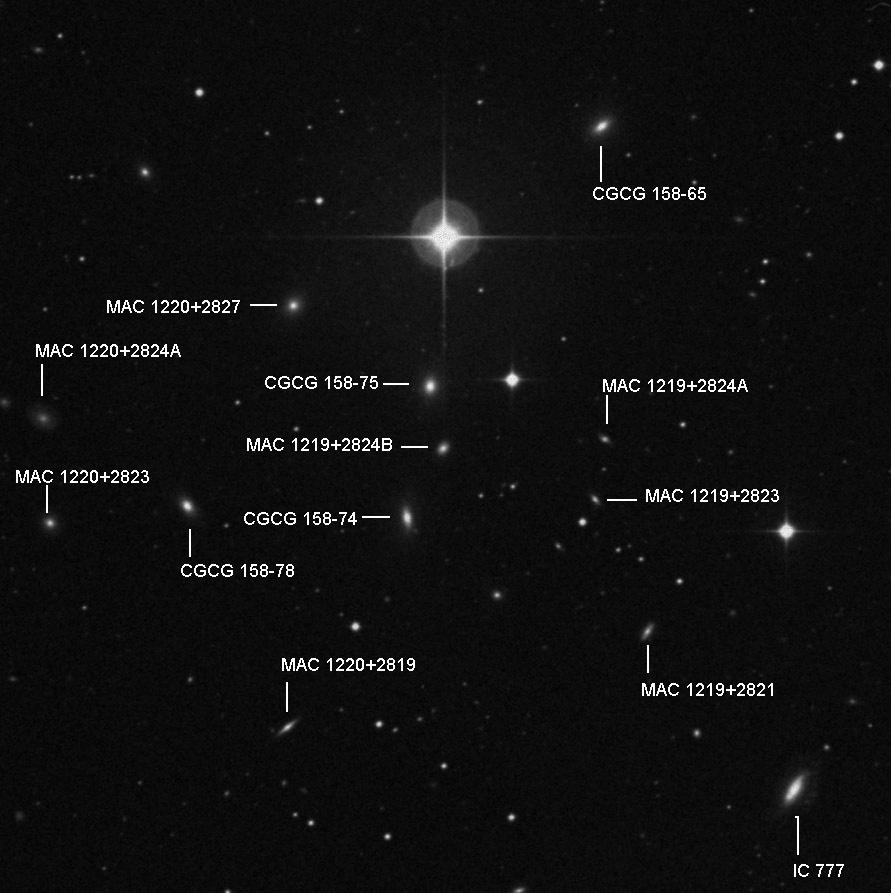
Shakhbazian 202
22 @ 383 and 460x
Nice loose group of 12 galaxies. This is one of the brighter Shk groups and not surprisingly all are visible in my 22 telescope.
IC 777 not a member
CGCG 158-74 Considerably bright 2:1 elongated glow with a brighter center. Defined edges.
CGCG 158-75 Considerably bright round glow with defined edges and brighter center.
CGCG 158-65 Considerably bright 2:1 elongated glow with a brighter center. Defined edges.
CGCG 158-78 Considerably bright slightly elongated glow with a brighter center. Defined edges.
MAC 1219+2821 Very faint 2:1 elongated even surface brightness glow.
MAC 1219+2823 Very faint very small round glow
MAC 1219+2824A Very faint very small round glow
MAC 1219+2824B Faint small round glow
MAC 1220+2819 Faint 3:1 elongated even surface brightness glow.
MAC 1219+2827 Faint round glow with brighter center
MAC 1220+2824A Extremely faint even and low surface brightness glow
MAC 1220+2823 Faint small round glow
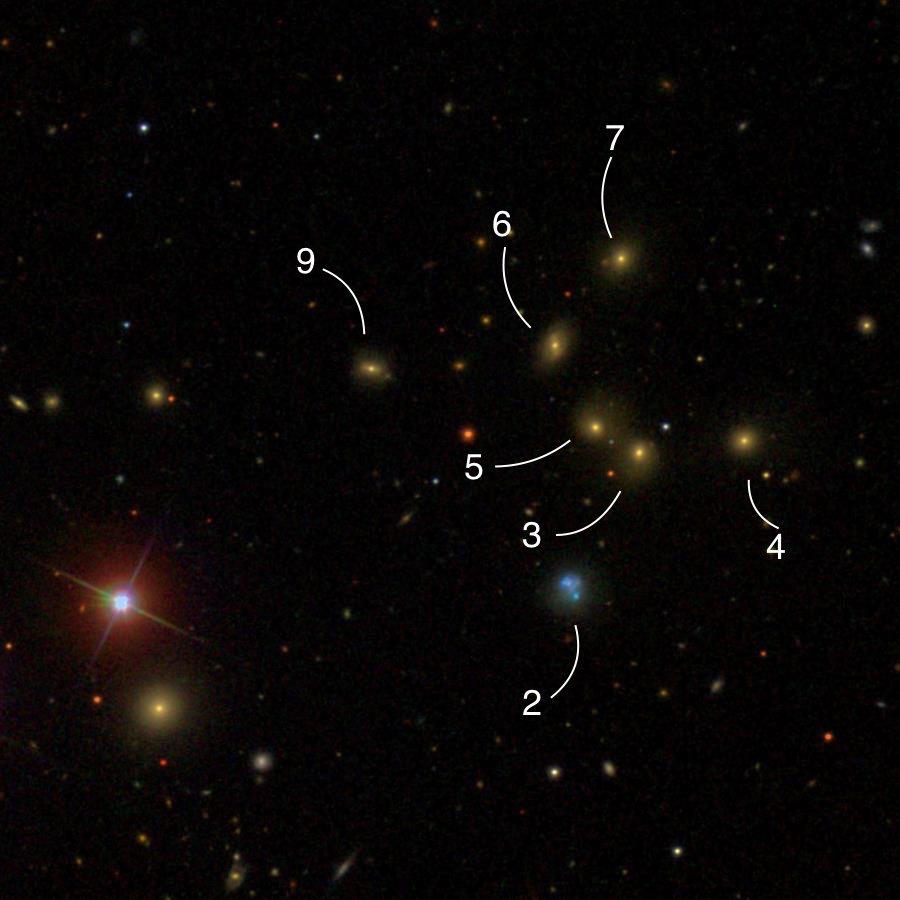
Shakhbazian 205
48 @ 488x 7 members seen.
5 members (3, 4, 5 ,6 ,7) of equal brightness forms a semi-circle about 1.5 in diameter.
The two other members (2 and 9) are opposite of the circle and appears like the constellation Crater. An extremely faint star sits between 4 and 7.
Note: I didn't look for any other members, even though they should be seen with the 48".
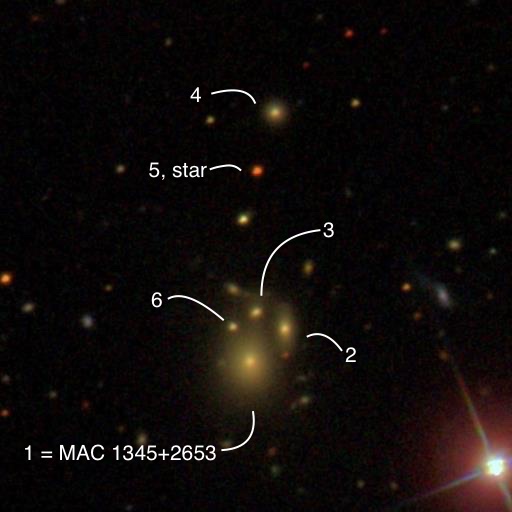
Shakhbazian 213
48 @ 488x Total of five galaxies seen and one labelled star are seen.
Component 1, MAC 1345+2653, is by far the brightest of the bunch and is slightly elongated even surface brightness glow.
Component 6 is a nearly stellar glow just off the NNE edge.
Components 2 and 3 are slightly further, but very close to the edge of MAC 1345+2653 and are very small round glows.
Component 4 is a faint, very small round glow.
A 10.0 mag star lies 1.7 WSW of MAC 1345+2653. Best to keep that star off the field using a narrow field eyepiece, such as an orthoscopic or a supermonocentric.
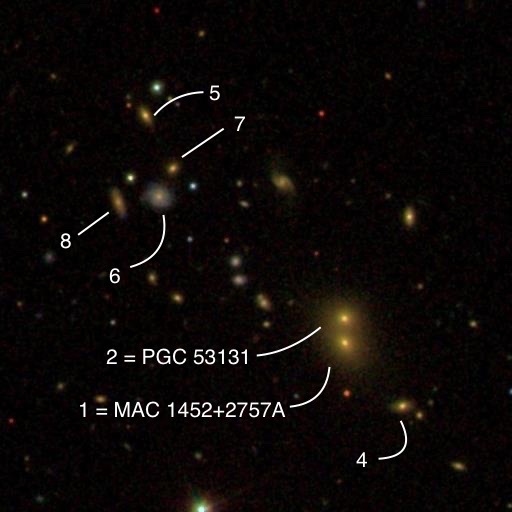
Shakhbazian 219
48 @ 488 and 610x Only 5 galaxies seen.
The two brighter ones labeled as PGC 53131 and MAC 1452+2757A are fairly faint round glows and almost merged. Both have much brighter centers.
Components 6, 7 and 8 are very faint small even surface brightness round glows.
A very faint star is among the 6 to 8 group, just NW of component 8.
Components 5 and 4 was not seen.
The rest of the unmarked members were also not seen.
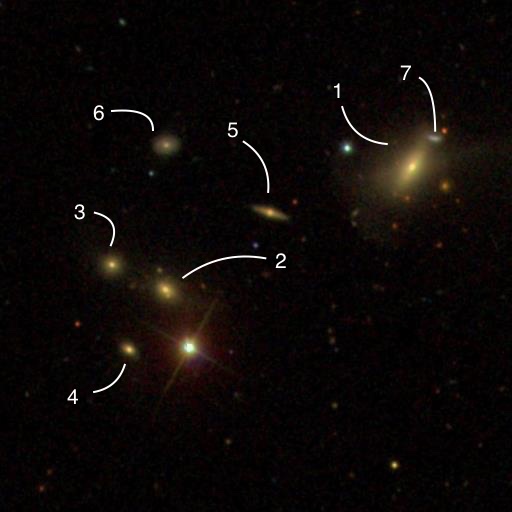
Shakhbazian 237
22 @ 383, 460 and 591x five members seen and two (6 and 7) were not seen.
Brightest member, 1, is on the west edge. Considerably bright 2:1 elongated glow with a much brighter center and diffuse edges. A foreground star lies to the east.
Component 7 to the NW not seen.
To the NE of that are three members (2, 3, and 4) arranged in a loose 45-dgree right triangle. The brightest of the three (2) is at the right angle and is a faint small round glow with a brighter center. The other two members (3 and 4) are equal brightness and considerably faint round glows.
The fifth member (5) a very faint, very small slightly elongated glow. It sits roughly between the brightest member (1) and the second brightest member (2).

Shakhbazian 258
22 @ 383, 460 and 591x - Poor cluster. Mostly stars. The brightest "1" is a considerably bright round glow with a brighter center and diffuse edges. The only other galaxy "4" in the field is due west and is a considerably faint, slightly elongated glow with a somewhat brighter center.
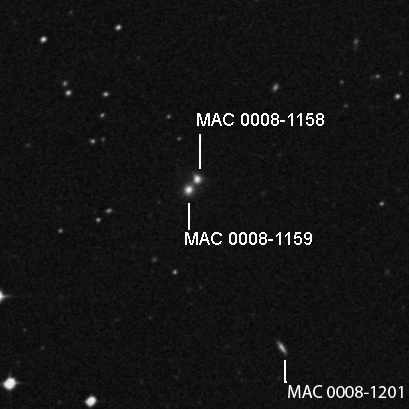
Shakhbazian 262
22 @ 328 and 383x Very faint double galaxy, MAC 0008-1158 and MAC 0008-1159, positioned 0.2 apart and PA = 135. Both are round and very small. Even surface brightness.

Shakhbazian 265
22 @ 383x Just two galaxies detected. Both are extremely faint round glows and are outliers, not really part of the cluster. None of the cluster members were seen. I must try this cluster again.
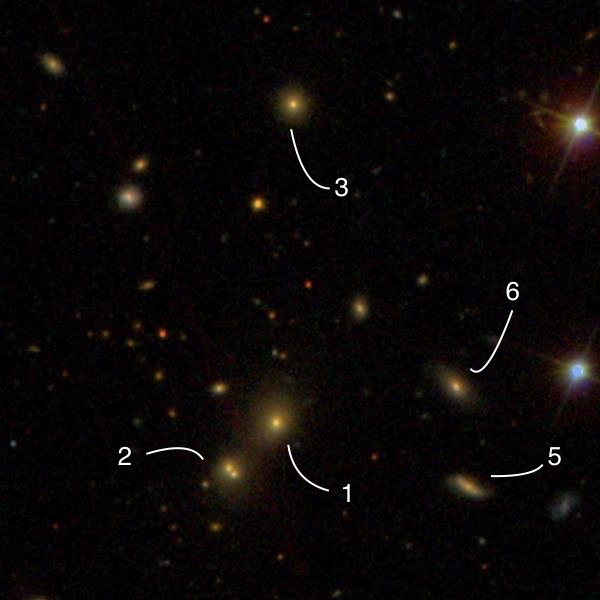
Shakhbazian 270
22 @ 306 and 460x Three very faint and two extremely faint members detected at 306x.
The pair of very faint (1 and 2) galaxies are 25 apart and the pair of extremely faint galaxies (5 and 6) are 1 apart. Another very faint galaxy (A) was seen about 2 north of the very faint pair. A pair of bright 12.9 and 13.5 mag stars lies about 2 west. I kept that off the field at 460x using the 5mm TMB Supermonocentric eyepiece and that helped a lot in detecting 5 and 6.

Shakhbazian 279
22 @ 306 and 460x A pair of considerably faint galaxies detected. The south member is slightly brighter than the northern galaxy. About 40 apart.
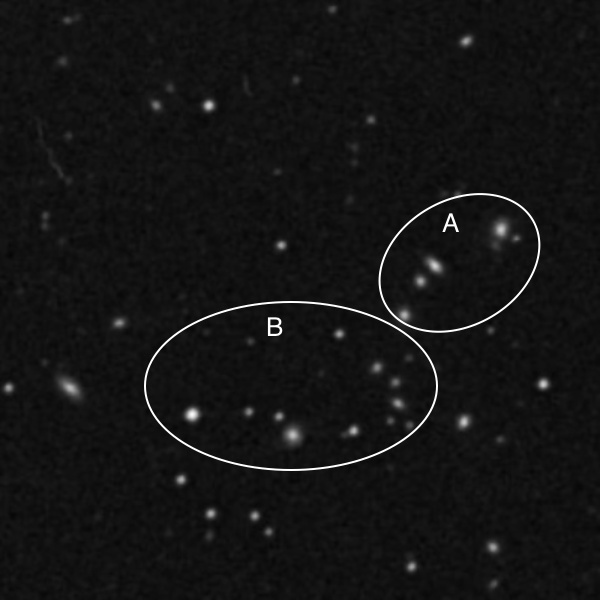
Shakhbazian 296
22 @ 328, 383 and 460x Lumpy darkness, not well resolved. Group A was seen as one glow and group B was pretty lumpy.
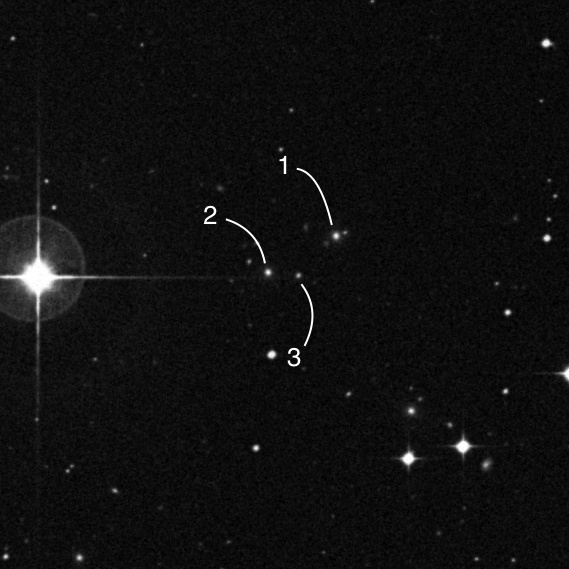
Shakhbazian 302
22 @ 383, 460 and 575x Observed three members.
2 brightest of the bunch, considerably faint, very small round glow.
1 Very faint, very small round glow
3 Extremely faint, very small round glow.
The three visible members form a very shallow equilateral triangle. A blazing mag 6.3 star lies just 4.0 west inhibits the view, if not kept off the field. A string of 11 to 12th magnitude stars lies about 4.3SW.
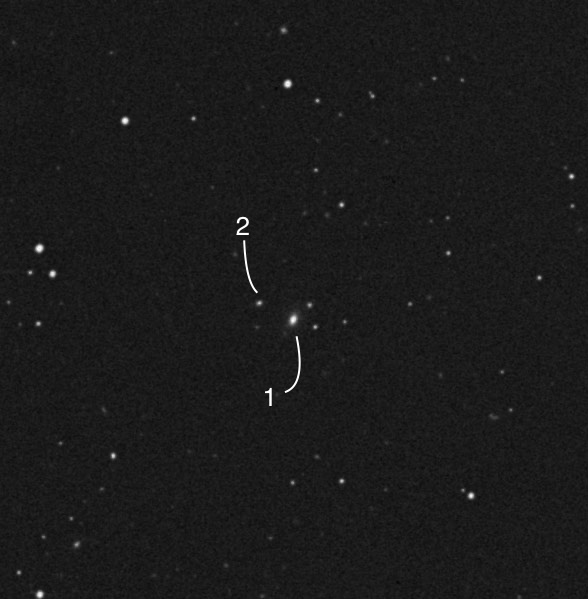
Shakhbazian 304
22 @ 383 and 460x Only two members seen.
1 is held steadily as a considerably faint small round glow.
2 pops in and out.
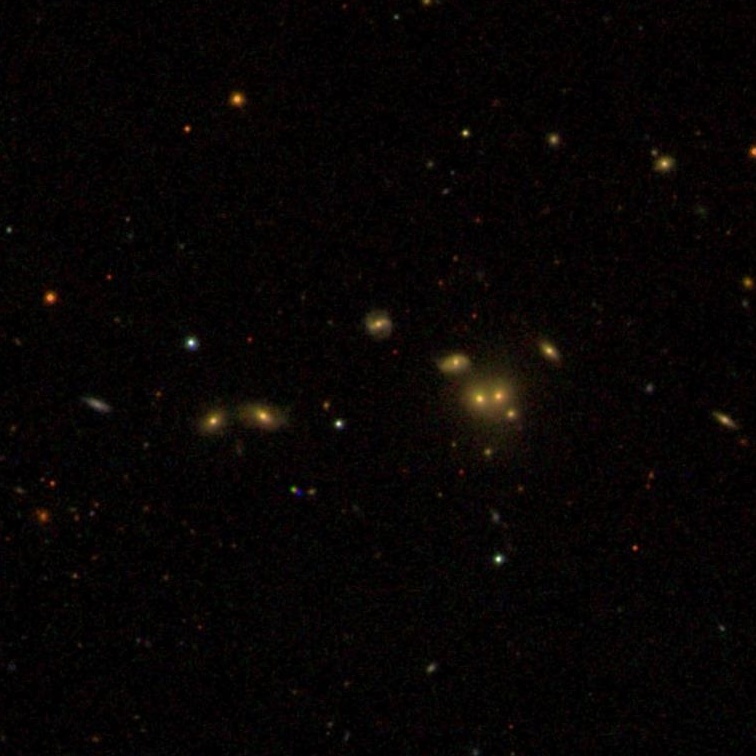
Shakhbazian 309
22 @ 383x This observation is not quite positive as it is a very star poor region. At 383x, there were no stars in the field. I suspected some lumpy darkness in the area. Next time, Ill use a wide field eyepiece to center on this group and try again.
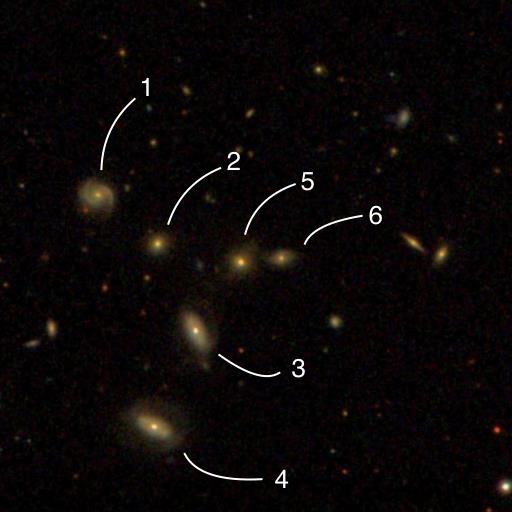
Shakhbazian 310
22 @ 306 and 460x Total of six members seen. Three were immediately picked up, while the other three didnt come to view until later and at 460x
4 Very faint 2:1 elongated glow with a brighter center. PA = 120.
3 Very faint 2:1 elongated glow with a brighter center. PA = 90. Identical in appearance as A.
1 Very faint round diffuse glow.
2, 5, and 6 - Extremely faint round glows. Pops in out and at 460x, more in than out, about 75%.
All six galaxies lies in a 2 circle.
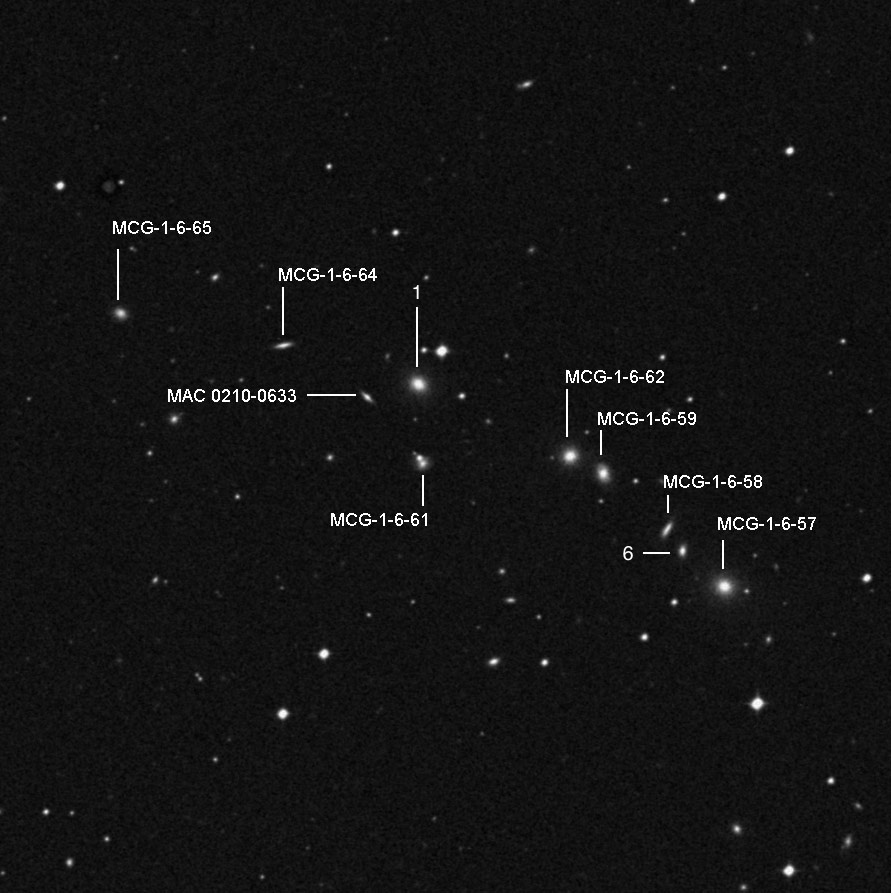
Shakhbazian 317
22 @ 287 and 460x - Nice string of galaxies. 6 were immediately seen at 287x.
Upon further observation, two more galaxies were detected at the east end, MCG 1-6-64 and -65. At 460x, one more galaxy, which is unlabeled B was detected.
The six seen, from west to east, were MCG-1-6-57, 58, 59, 60, 61 and an unlabeled 6. The unlabeled galaxy 1, which is the brightest of the chain, is closest to the 13.6 mag star.
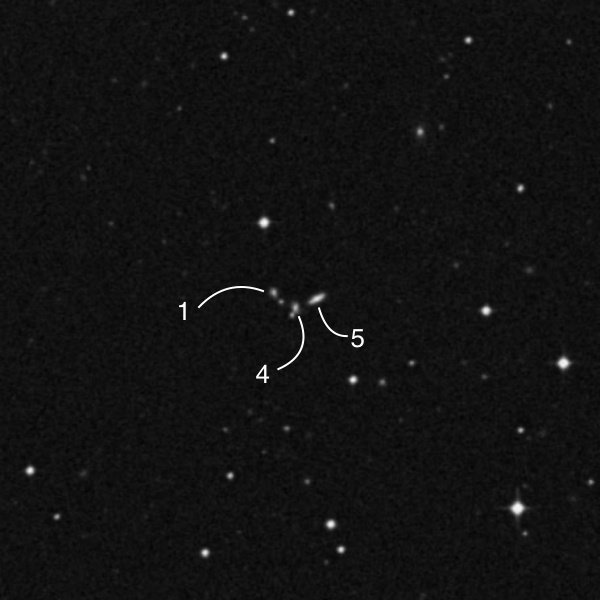
Shakhbazian 318
48 @ 488, 542 and 610x four galaxies detected, much like a flat isosceles triangle.
The western member, A, is a considerably faint 5:2 elongated even surface brightness glow. PA = 120 and 0.2 long.
The eastern member, B, is extremely faint round glow. About 0.1 across. Lies 0.5 due east of the first member.
The third and fourth members, C, are a very close double galaxy, on the south tip. The southern member is very faint very small round glow with a stellar core. The north member of the pair is very faint soft round glow, about 0.1 across.
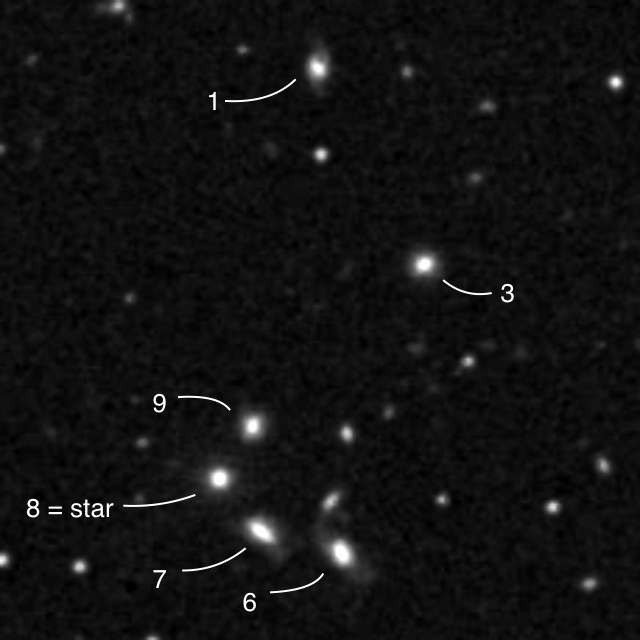
Shakhbazian 320
22 @ 383, 460 and 591x nice group of 3 visible members with two additional members to the north.
The three members (6, 7 and 9) form an equidistant 30-60-90 triangle with a star at the right angle. The three members appear the same as very faint round small glows.
The other two members (1 and 3) to the north are also very faint round glows.
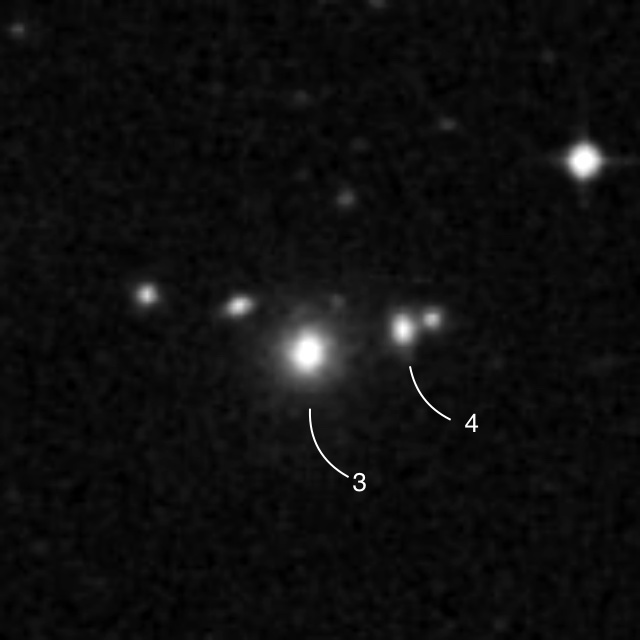
Shakhbazian 322
22 @ 383, 460 and 591x Group of five galaxies, which I see only two.
The middle galaxy (3) is a faint round flow with a much brighter center.
The other visible galaxy (4) is to the west and a very faint small round glow.
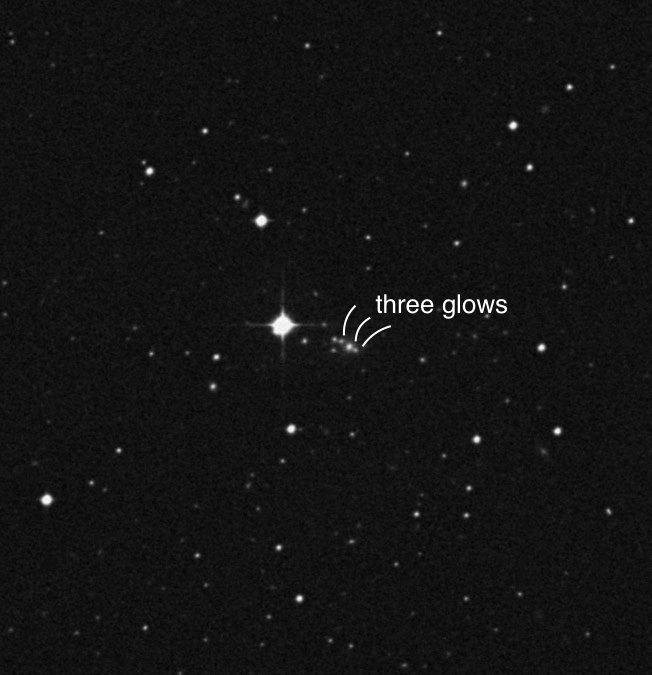
Shakhbazian 323
48 @ 488 and 813x A very faint elongated glow punctuated with 3 very faint stellar equidistant cores. 0.4 long and PA = 75 degrees. A mag 9.6 star lies 0.9 east of the east end of the chain.
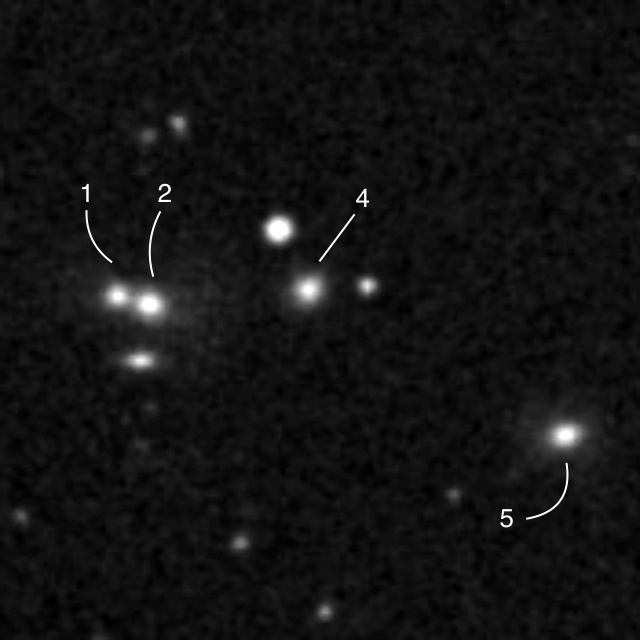
Shakhbazian 327
22 @ 383, 460 and 591x Four members were seen. All four were the same size and brightness. Very faint very small round glows. Two (1 and 2) on the east were barely resolved with a PA = 90. The one in the middle (4) was to the SW of a foreground star and the west galaxy (5) was a little south of due west of the group.
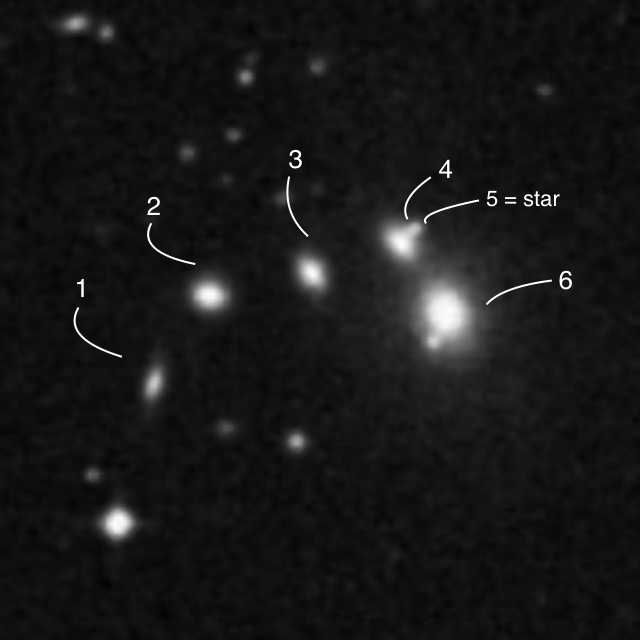
Shakhbazian 328
22 @ 383, 460 and 591x five members seen.
The brightest (6) is a considerably faint very slightly elongated glow with a much brighter center. There is a star just off the SSE edge.
Three equidistant galaxies (2 to 4) are roughly equal brightness with the middle one (3) slightly fainter. All are faint small round even surface brightness glows. An extremely faint star (5) is just to the west of the west most galaxy (4) of the chain.
The fifth member (1) was barely picked up as an extremely faint round glow located to the SE of the east most member (2) of the chain.

Shakhbazian 331
22 @ 306 and 460x 3 very faint galaxies resolved in a very tight group of about 30 long. The brightest member on the north end was not resolved from the very small companion to the west.
One very faint galaxy lies 3.1 WNW of the trio. An extremely faint galaxy is 3.8 east of the trio.

Shakhbazian 352
22 @ 383, 460, and 591x seven members seen.
The three brightest (1, 2, and 3) are faint round glows with a brighter center arranged in a slightly bent equidistant line.
4 and 5 are very faint round glows.
6 is extremely faint very small round glow.
7 pops in and out as an extremely faint tiny round glow. 6 and 7 picked up only at 591x.
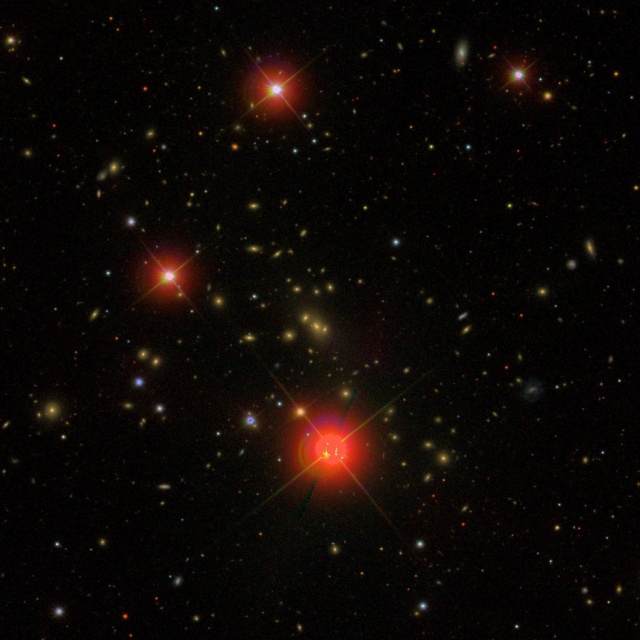
Shakhbazian 357
22 @ 383, 460, and 591x distant rich field of galaxies. At least 5 individual galaxies were picked up, but the rest appeared as lumpy darkness. I didnt spend the time to mark each individual galaxy, but I hope to do that the next time I observe this group.
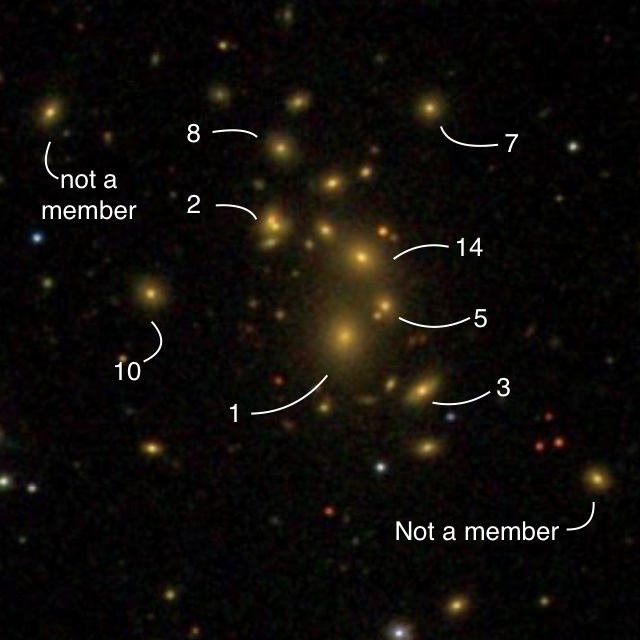
Shakhbazian 360
48 @ 488 and 813x 8 members seen in a very tight crowded field plus two non members. Needed to spend a little more time than usual to resolve the individual members. 14 was the brightest while 1 was the second brightest. The rest are faint to very faint very small round glows.

Shakhbazian 361
22 @ 459x and 638x A total of five galaxies were detected. Two southernmost galaxies (1 and 6) appear to be almost merged, separated by less than 10. The southern one (1) is a very faint, very small round patch. The northern galaxy of the pair (6) is a very faint 2:1 elongated glow. PA = 0.
Moving about 1.0 to the NW of the galaxy pair, 2 is a very faint round glow. Moving 45 to the WNW lies (3) as an extremely faint round glow. The northern most galaxy (4) lying 1.7 north of the first discussed pair, appears as a very faint round glow.

Shakhbazian 362
22 @ 306, 383, 459 and 638x Four very to extremely faint very small round glows in a slight arc appointed with a stellar core for each galaxy. The arc goes from west to east arcing northwards. Distance from end to end is 0.8 long.
A 10.2 magnitude star lies just 1.7 NW of the trio. Best to keep it off the field.

Shakhbazian 374
48 @ 488 and 813x Five very faint small round glows detected in a rough L shaped asterism. A blazing mag 7.5 star lies just 1.9 due south. Best at 813x with the 6mm ZAO-II eyepiece just to keep the star off the field. 1.0 long and 0.5 wide.
Back to Observing Reports
All Observing Reports are copyrighted by Alvin Huey. You can print them for personal use only.
